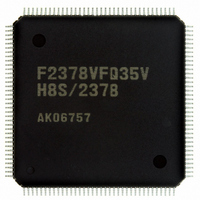DF61657CN35FTV Renesas Electronics America, DF61657CN35FTV Datasheet - Page 800

DF61657CN35FTV
Manufacturer Part Number
DF61657CN35FTV
Description
IC H8SX/1657 MCU FLASH 120TQFP
Manufacturer
Renesas Electronics America
Series
H8® H8SX/1600r
Datasheet
1.DF61656N35FTV.pdf
(894 pages)
Specifications of DF61657CN35FTV
Core Processor
H8SX
Core Size
32-Bit
Speed
35MHz
Connectivity
SCI, SmartCard
Peripherals
DMA, PWM, WDT
Number Of I /o
82
Program Memory Size
768KB (768K x 8)
Program Memory Type
FLASH
Ram Size
24K x 8
Voltage - Supply (vcc/vdd)
3 V ~ 3.6 V
Data Converters
A/D 8x10b; D/A 2x8b
Oscillator Type
Internal
Operating Temperature
-20°C ~ 75°C
Package / Case
120-TQFP, 120-VQFP
For Use With
3DK1657 - DEV EVAL KIT FOR H8SX/1657
Lead Free Status / RoHS Status
Lead free / RoHS Compliant
Eeprom Size
-
Available stocks
Company
Part Number
Manufacturer
Quantity
Price
Company:
Part Number:
DF61657CN35FTV
Manufacturer:
RENESAS
Quantity:
101
Company:
Part Number:
DF61657CN35FTV
Manufacturer:
Renesas Electronics America
Quantity:
10 000
- Current page: 800 of 894
- Download datasheet (5Mb)
Section 20 Power-Down Modes
20.9
Sleep Instruction Exception Handling
Sleep instruction exception handling is the exception handling initiated by the execution of a
SLEEP instruction. Sleep instruction exception handling is always accepted while the program is
in execution.
When the SLPIE bit is set to 0, the execution of a SLEEP instruction does not initiate sleep
instruction exception handling. Instead, the CPU enters the power-down state. After this,
generation of an exception handling request that cancels the power-down state causes the power-
down state to be canceled, after which the CPU starts to handle the exception. When the SLPIE bit
is set to 1, sleep instruction exception handling starts after the execution of a SLEEP instruction.
Transitions to the power-down state are inhibited when sleep instruction exception handling is
initiated, and the CPU immediately starts sleep instruction exception handling.
When a SLEEP instruction is executed while the SLPIE bit is cleared to 0, a transition is made to
the power-down state. The power-down state is canceled by a canceling factor interrupt (see figure
20.5).
When a canceling factor interrupt is generated immediately before the execution of a SLEEP
instruction, exception handling for the interrupt starts. When execution returns from the exception
service routine, the SLEEP instruction is executed to enter the power-down state. In this case, the
power-down state is not canceled until the next canceling factor interrupt is generated (see figure
20.6).
When the SLPIE bit is set to 1 in the service routine for a canceling factor interrupt so that the
execution of a SLEEP instruction will produce sleep instruction exception handling, the operation
of the system is as shown in figure 20.7. Even if a canceling factor interrupt is generated
immediately before the SLEEP instruction is executed, sleep instruction exception handling is
initiated by execution of the SLEEP instruction. Therefore, the CPU executes the instruction that
follows the SLEEP instruction after sleep instruction exception and exception service routine
without shifting to the power-down state.
When the SLPIE bit is set to 1 to start sleep exception handling, clear the SSBY bit in SBYCR
to 0.
Rev. 2.00 Jun. 28, 2007 Page 774 of 864
REJ09B0341-0200
Related parts for DF61657CN35FTV
Image
Part Number
Description
Manufacturer
Datasheet
Request
R

Part Number:
Description:
KIT STARTER FOR M16C/29
Manufacturer:
Renesas Electronics America
Datasheet:

Part Number:
Description:
KIT STARTER FOR R8C/2D
Manufacturer:
Renesas Electronics America
Datasheet:

Part Number:
Description:
R0K33062P STARTER KIT
Manufacturer:
Renesas Electronics America
Datasheet:

Part Number:
Description:
KIT STARTER FOR R8C/23 E8A
Manufacturer:
Renesas Electronics America
Datasheet:

Part Number:
Description:
KIT STARTER FOR R8C/25
Manufacturer:
Renesas Electronics America
Datasheet:

Part Number:
Description:
KIT STARTER H8S2456 SHARPE DSPLY
Manufacturer:
Renesas Electronics America
Datasheet:

Part Number:
Description:
KIT STARTER FOR R8C38C
Manufacturer:
Renesas Electronics America
Datasheet:

Part Number:
Description:
KIT STARTER FOR R8C35C
Manufacturer:
Renesas Electronics America
Datasheet:

Part Number:
Description:
KIT STARTER FOR R8CL3AC+LCD APPS
Manufacturer:
Renesas Electronics America
Datasheet:

Part Number:
Description:
KIT STARTER FOR RX610
Manufacturer:
Renesas Electronics America
Datasheet:

Part Number:
Description:
KIT STARTER FOR R32C/118
Manufacturer:
Renesas Electronics America
Datasheet:

Part Number:
Description:
KIT DEV RSK-R8C/26-29
Manufacturer:
Renesas Electronics America
Datasheet:

Part Number:
Description:
KIT STARTER FOR SH7124
Manufacturer:
Renesas Electronics America
Datasheet:

Part Number:
Description:
KIT STARTER FOR H8SX/1622
Manufacturer:
Renesas Electronics America
Datasheet:

Part Number:
Description:
KIT DEV FOR SH7203
Manufacturer:
Renesas Electronics America
Datasheet:











